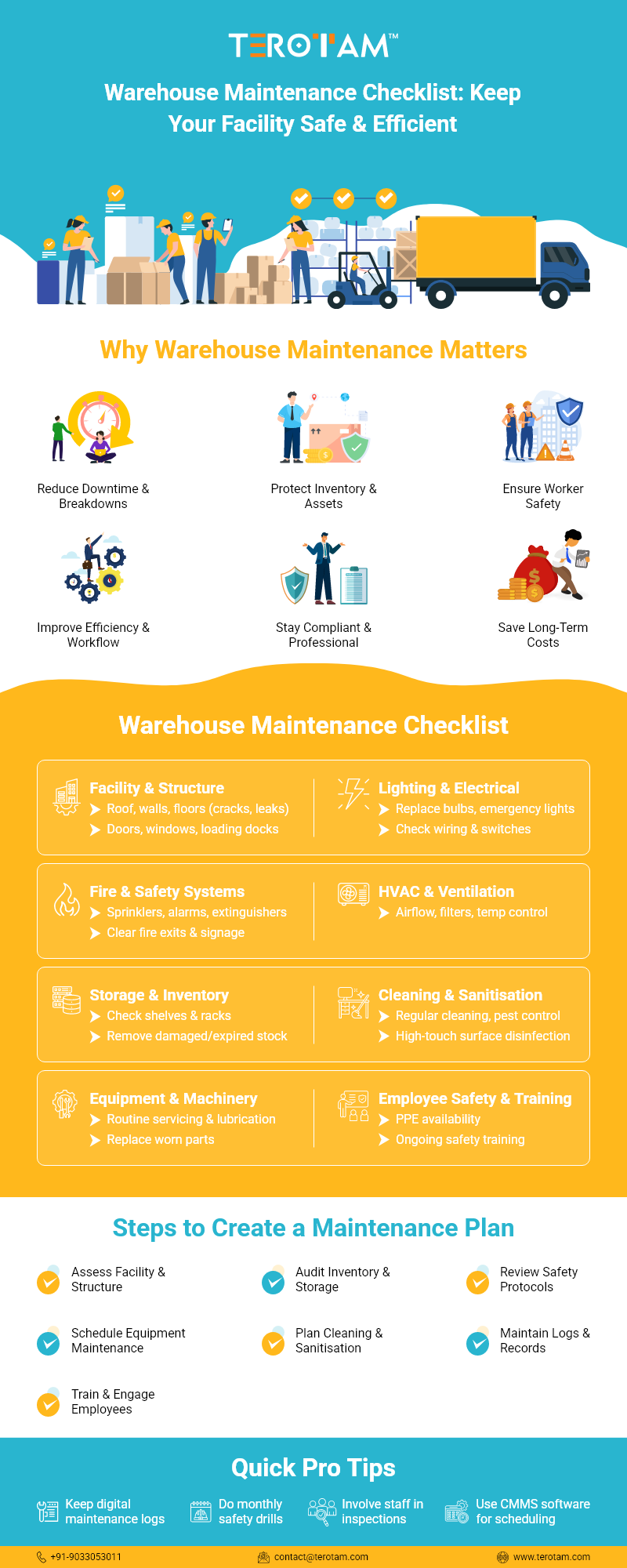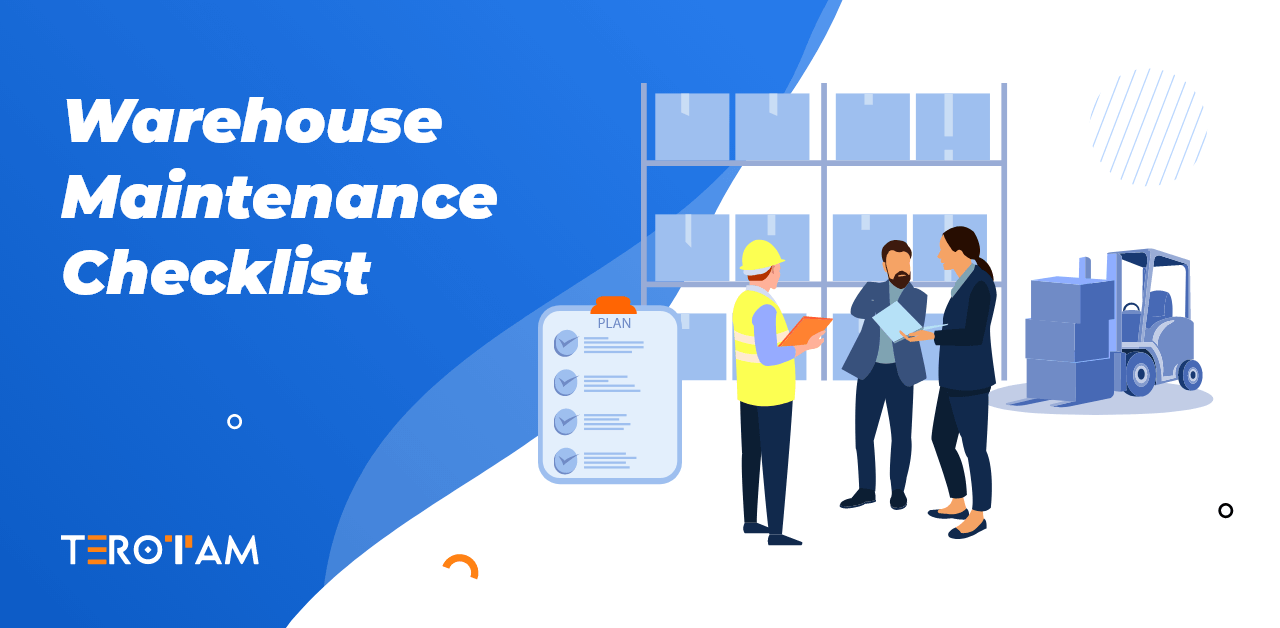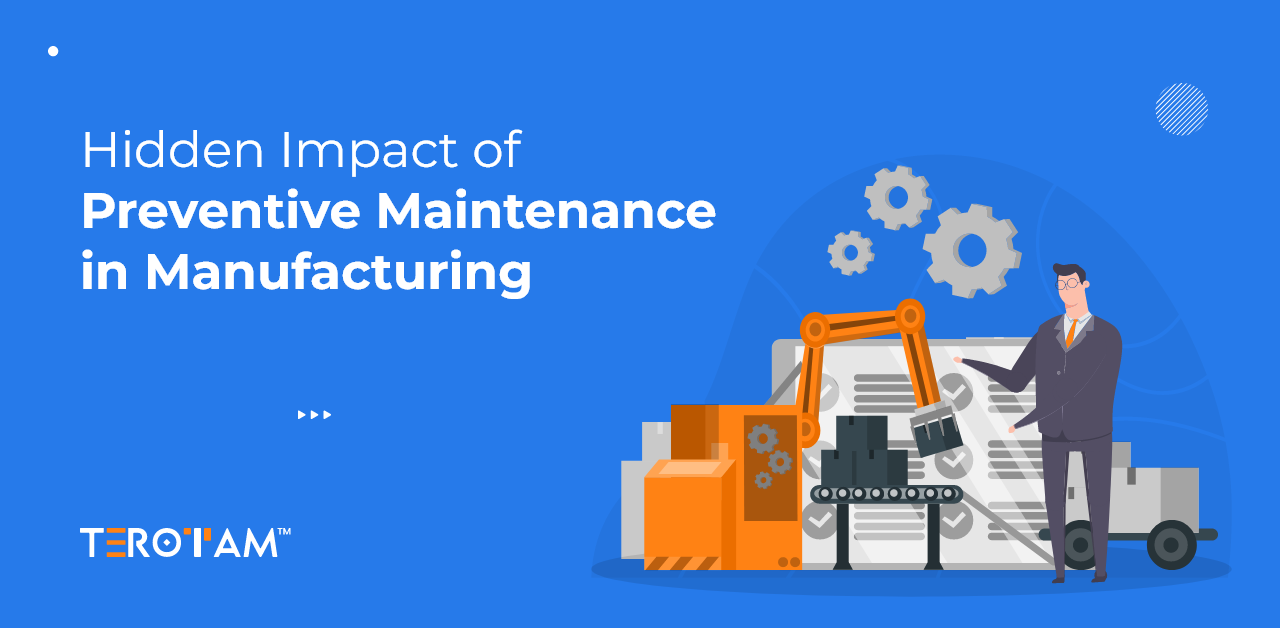An Efficient and Systematic warehouse is essential to any successful supply chain. The effectiveness and dependability of warehouse operations may make or destroy a company in the logistics business.
An approach to maintenance that is both proactive and systematic is becoming more and more important as warehouses evolve into complex centers of automation and technology. Ignoring warehouse maintenance can have a cascading effect on your business, affecting everything from personnel safety to inventory control.
In this post, we’ll attempt to explain the importance of warehouse maintenance and how a well-designed checklist can be the key to achieving optimal operating efficiency.
Why is Warehouse Maintenance a Must?
As we talk about modern supply chain management, the role of warehouses extends beyond mere storage spaces. A well-kept warehouse ensures that goods move quickly from supplier to customer and is a crucial component of a smooth supply chain. The immediate impact that maintenance has on operating efficiency is one of the key reasons it is so important. Periodic and planned maintenance of infrastructure and equipment lowers the chance of unplanned breakdowns, which would otherwise cause downtime and disturb the complex web of logistical operations.
The condition of a warehouse can reveal a lot about how committed a business is to quality. A clean warehouse enhances the brand at a time when consumers have higher expectations than before. It reduces the possibility of mistakes in the selection, packaging, and shipping processes and ensures the integrity of the products being stored. As a result, the supply chain is more dependable and efficient, which increases customer satisfaction and loyalty.
Warehouse maintenance is essential to workplace safety beyond operational effectiveness and brand reputation. Employee safety at warehouses may be at risk due to hazardous conditions caused by neglected maintenance. Preventive maintenance protects the workers and the warehouse’s valuable Inventory by checking the facility’s structural integrity and routine inspection of the equipment.

The Pitfalls of Neglecting Warehouse Maintenance
Operational Downtime
Neglecting maintenance increases the risk of unexpected equipment breakdowns, causing operational downtime and delaying shipments.
Inventory Damage
Lack of upkeep contributes to an environment prone to accidents, resulting in damaged inventory and potential financial losses.
Safety Concerns
Deferred maintenance leads to safety hazards, jeopardizing the well-being of warehouse personnel and creating an unsafe working environment.
Inefficient Workflows
Poorly maintained machinery and disorganized storage systems hinder efficient workflows, impacting overall operational productivity.
Why is the Warehouse Maintenance Checklist Important?
A meticulously crafted warehouse maintenance checklist is more than a piece of paper; it is a strategic tool that ensures your warehouse’s longevity, reliability, and overall functionality.
A warehouse maintenance checklist is a proactive safeguard, preventing potential issues before they escalate into significant disruptions. The significance of such a checklist becomes particularly apparent in the face of the ever-growing complexities of modern warehouses, where technology and automation are integral components.
Here are some crucial reasons why a warehouse maintenance checklist is indispensable for businesses navigating the complexities of logistics:
Systematic Approach:
Provides a systematic and organized framework for identifying, addressing, and tracking maintenance needs throughout the warehouse.
Preventive Measures:
Serves as a proactive tool to anticipate and prevent potential issues before they escalate, minimizing downtime and disruptions.
Resource Optimization:
Facilitates efficient allocation of resources by prioritizing maintenance tasks based on urgency and importance.
Operational Consistency:
Ensures a consistent standard of operational excellence by addressing structural, equipment, and safety concerns in a methodical manner.
Documentation and Accountability:
Enables thorough documentation of maintenance activities, creating a record for analysis, accountability, and future planning.
Adaptability to Change:
Provides flexibility to adapt to evolving warehouse needs and technologies by incorporating new maintenance requirements into the checklist.
Cost-Effective Maintenance:
Promotes cost-effective maintenance practices by preventing major issues that may lead to emergency repairs or equipment replacements.
Compliance Assurance:
It helps maintain compliance with safety regulations, reduces the risk of legal issues, and ensures a secure working environment.
Steps to Prepare a Detailed Warehouse Maintenance Checklist
Comprehensive Facility Assessment:
- Walkthrough Evaluation: Conduct a thorough walkthrough of the entire warehouse facility.
- Structural Analysis: Examine roofing, flooring, and walls for signs of wear or damage.
Inventory and Storage Area Inspection:
- Inventory Audit: Regularly assess inventory for damaged or expired goods.
- Storage Organization Review: Evaluate the organization and cleanliness of storage areas.
- Shelving Integrity Check: Ensure the structural integrity of shelving and storage systems.
Safety Protocols and Compliance Review:
- Protocol Update: Regularly review and update safety protocols to align with industry standards.
- Routine Inspections: Conduct routine inspections of emergency exits, fire extinguishers, and safety measures.
- Compliance Assurance: Ensure the warehouse complies with health and safety regulations.
Equipment Maintenance Schedule Creation:
- Maintenance Schedule Development: Develop a comprehensive maintenance schedule for all equipment.
- Routine Checks: Include routine checks, lubrication of moving parts, and replacement of worn-out components.
Cleaning and Sanitization Procedures:
- Cleaning Schedule Implementation: Implement a regular cleaning schedule for the entire warehouse.
- High-Touch Surface Sanitization: Establish protocols for regularly sanitizing high-touch surfaces and equipment.
Documentation and Record-Keeping:
- Establish Documentation System: Set up a system for documenting all maintenance activities.
- Detailed Records: Keep detailed records of equipment inspections, repairs, and structural enhancements.
Employee Training and Involvement:
- Training Initiatives: Ensure thorough training of warehouse staff on safety protocols.
- Cultivate Responsibility: Encourage a culture where employees actively report issues and contribute to the maintenance process.
Ready to Use Warehouse Maintenance Checklist Samples
1. General Maintenance Checklist:
Structural Components:
- Roofing inspection for leaks, cracks, and integrity.
- Flooring assessment for wear, tripping hazards, and cleanliness.
- Wall integrity check for cracks, dampness, and stability.
Doors and Entrances:
- Inspection of door hinges, locks, and automatic mechanisms.
- Functionality of loading dock equipment and levelers.
Windows and Ventilation Systems:
- Examination of windows for cracks and energy efficiency.
- Inspection of ventilation systems for proper airflow.
Lighting Systems:
- Evaluation of lighting fixtures and replacement of malfunctioning bulbs.
- Assessment of emergency lighting and exit signs.
Fire Suppression Systems:
- Functionality of sprinkler systems and fire alarms.
- Inspection of fire extinguishers and their accessibility.
HVAC Systems:
- Regular maintenance of heating, ventilation, and air conditioning systems.
- Air quality checks and filter replacements.
Inventory and Storage:
- Inventory audit for damaged or expired goods.
- Assessment of storage organization and cleanliness.
- Inspection of shelving and storage system integrity.
Equipment Maintenance:
- Machinery maintenance schedule creation and adherence.
- Lubrication of moving parts and replacement of worn components.
- Record-keeping for repairs, maintenance, and equipment history.
Cleaning and Sanitization:
- Implementation of a detailed cleaning schedule.
- Regular sanitization of high-touch surfaces and equipment.
- Pest control measures to prevent infestations.
Electrical Systems:
- Inspection of wiring and electrical panels for safety.
- Testing of electrical outlets and switches.
Security Systems:
- Functionality check of surveillance cameras and alarms.
- Access control system assessment and updates.
2. Safety Inspection Checklist:
Emergency Preparedness:
- Functional emergency exits and lighting.
- Adequate signage for evacuation routes.
- Updated first aid supplies and kits.
Fire Safety:
- Functional fire extinguishers.
- Fire alarm system checks.
- Clearance around fire exits and equipment.
Personal Protective Equipment (PPE):
- Availability and condition of PPE.
- Employee training on proper PPE usage.
- Regular checks on PPE compliance.
Machinery Safety:
- Proper functioning of safety guards on machinery.
- Employee training on machinery safety protocols.
- Lockout/tagout procedures in place.
3. Warehouse Maintenance Improvement Checklist:
Energy Efficiency:
- Assessment of lighting and HVAC systems efficiency.
- Implementation of energy-saving measures.
- Integration of sustainable practices.
Technology Integration:
- Evaluation of technology updates and integrations.
- Employee training on new technology implementations.
- Continuous improvement in automation processes.
Process Optimization:
- Review of current workflows for inefficiencies.
- Implementation of lean principles.
- Regular assessment and adaptation of processes.
Employee Training Programs:
- Training on new safety protocols and technologies.
- Continuous education on maintenance best practices.
- Feedback mechanisms for employee suggestions.
Conclusion
The importance of a well-maintained warehouse cannot be overstated. A strategic approach to warehouse maintenance, facilitated by a comprehensive checklist, serves as the backbone for operational excellence. By systematically addressing structural, safety, and equipment concerns, businesses can ensure the seamless flow of goods, enhance their brand reputation, and safeguard the well-being of their workforce. The adaptability and foresight provided by a detailed maintenance checklist become invaluable assets for warehouse maintenance management.
If you are on the same boat, seeking to sail in the water of systematic maintenance approach with best warehouse maintenance practices, streamline operations, and ensure long-term sustainability, our team of experts at TeroTAM is ready to assist. Connect with us now or write to us at contact@terotam.com. Your success is our priority.








